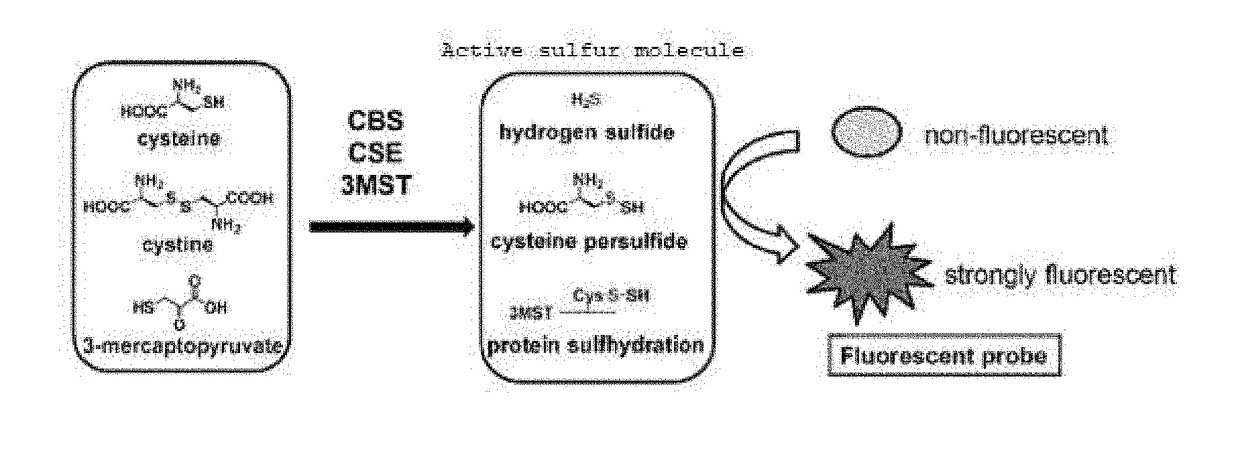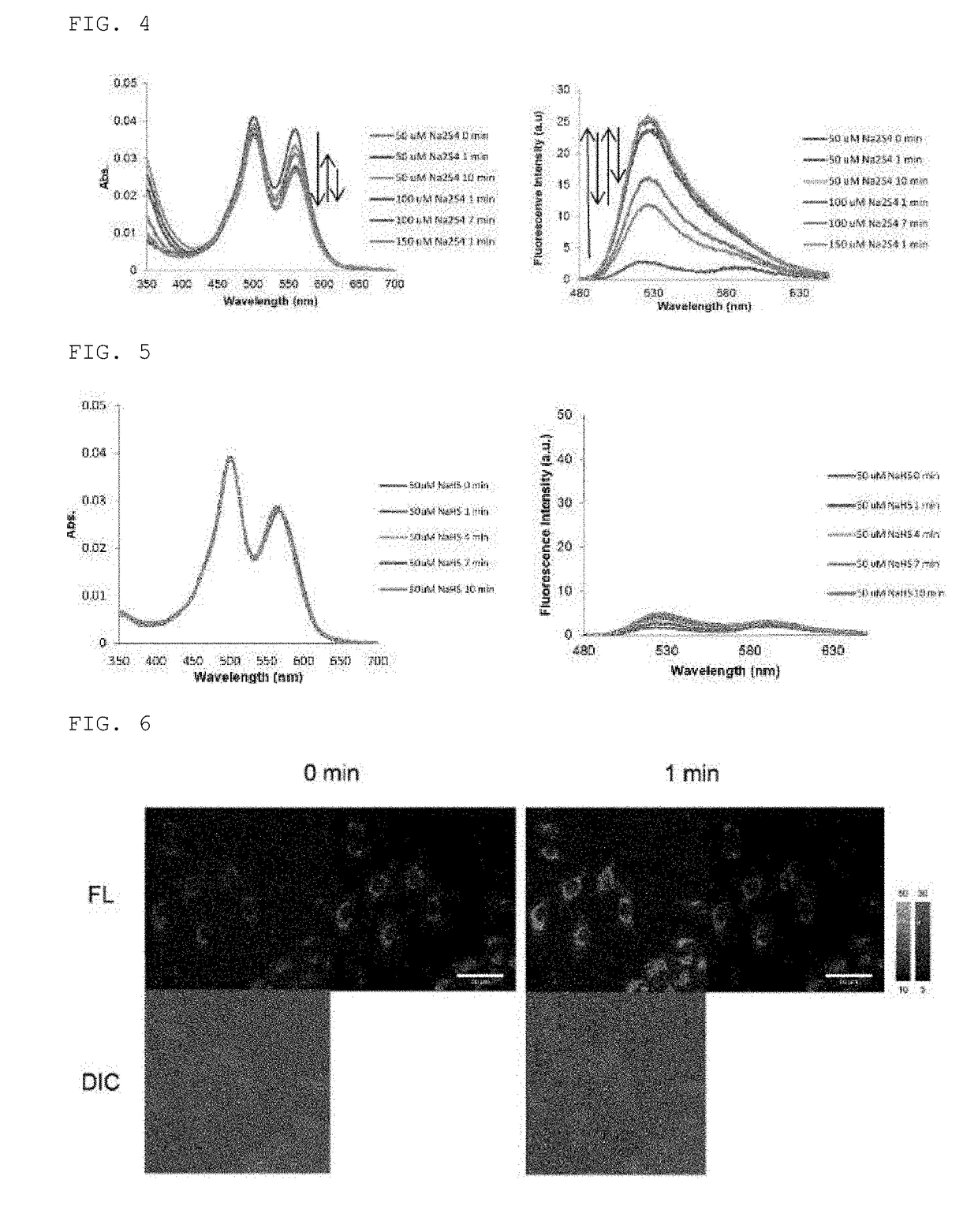Sulfane sulfur-selective fluorescent probe
a fluorescent probe and sulfur-selective technology, applied in the field of fluorescent probes, can solve the problems of low sensitivity and unsuitable for real-time measurement, and achieve the effect of excellent off/on and sufficient solubility in water
- Summary
- Abstract
- Description
- Claims
- Application Information
AI Technical Summary
Benefits of technology
Problems solved by technology
Method used
Image
Examples
synthesis example 1
Synthesis of Compound 8 (SSip-1) of the Present Invention
[0124]A synthesis intermediate for use in synthesizing compound 8 of the present invention was synthesized according to scheme 1 below.
(1) Synthesis of Compound 1
[0125]4-Bromobenzoic acid (5.06 g, 25.3 mmol) was placed in a flask, and chlorosulfonic acid (12 mL) was slowly added dropwise. The solution was heated under reflux for six hours at 140° C. After cooling to room temperature, the reaction solution was slowly added dropwise to ice water. A precipitate of the target substance was produced at that time. The precipitate was collected by a Buchner funnel, the funnel was washed by H2O, and 4-bromo-3-chlorosulfonylbenzoic acid (compound 1, 6.17 g, 20.7 mmol, yield 82%) was obtained. 1H NMR (400 MHz, Acetone-d): δ 8.23 (d, 1H, J=8.3 Hz), 8.33 (dd, 1H, J=8.3, 2.0 Hz), 8.74 (d, 1H, J=2.0 Hz.) 13C NMR (100 μMHz, Acetone-d6): δ 125.8, 132.1, 132.2, 137.8, 138.4, 143.8, 165.0. HRMS (ESI−): Calcd for [M−H]− 298.8604, Found 298.8589 ...
example 1
[0146]Na2S4 was added to compound 8 synthesized as described above, and the absorption spectrum (UV-1650PC, Shimadzu) and fluorescence spectrum (F-4500, Hitachi) were measured.
[0147]The left drawing of FIG. 3 shows the measurement results of the absorption spectrum of 1 μM of SSip-1 in 0.1 M sodium phosphate buffer (pH 7.4) in the presence of 300 μM of GSH after addition of 50 μM of Na2S4 (containing 0.1% DMSO and 1 mg / mL of BSA as co-solvents). The right drawing of FIG. 3 shows the measurement results of the fluorescence spectrum under the same conditions. The excitation wavelength was 470 nm.
[0148]A decrease in absorbance on the rhodamine side and a rise in fluorescence derived from fluorescein were seen after addition of 50 μM of Na2S4, and SSip-1 served as an OFF / ON type of fluorescent probe. Given that the concentration of glutathione persulfide (GSSH) which is a molecule that includes sulfane sulfur in cells is reported to be 10-100 μM and an approximately 10-fold rise in fluo...
synthesis example 2
Synthesis of Compound a1 (6-Fluorescein-SSip-1) of the Present Invention
[0164]Compound a1 of the present invention was synthesized according to the following scheme 4.
(1) Synthesis of Compound 9
[0165]6-Carboxyfluorescein (200 mg, 0.53 mmol) and N-Boc-trans-1,4-cyclohexanediamine (285 mg, 1.33 mmol) and N,N-diisopropylethylamine (686 mg, 5.32 mmol) and O-(7-azabenzotriazol-1-yl)-N,N,N′,N′-tetramethyluronium hexafluorophosphate (HATU) (403 mg, 1.06 mmol) were dissolved in dehydrated DMF (5 mL) and stirred for three hours at room temperature. The reaction was stopped by 1N HCl aq. This mixture was extracted by dichloromethane, and the organic layer was washed by brine, and the solvent was distilled off under reduced pressure after drying by Na2SO4. Some of the byproducts and reagent residues were then removed by subjecting the residue to HPLC (eluent, from 20% acetonitrile / 0.1% trifluoroacetic acid / water (0 min) to 80% acetonitrile / 0.1% trifluoroacetic acid / water (15 min); flow rate=5....
PUM
| Property | Measurement | Unit |
|---|---|---|
| temperature | aaaaa | aaaaa |
| pH | aaaaa | aaaaa |
| excitation wavelength | aaaaa | aaaaa |
Abstract
Description
Claims
Application Information
 Login to View More
Login to View More - R&D
- Intellectual Property
- Life Sciences
- Materials
- Tech Scout
- Unparalleled Data Quality
- Higher Quality Content
- 60% Fewer Hallucinations
Browse by: Latest US Patents, China's latest patents, Technical Efficacy Thesaurus, Application Domain, Technology Topic, Popular Technical Reports.
© 2025 PatSnap. All rights reserved.Legal|Privacy policy|Modern Slavery Act Transparency Statement|Sitemap|About US| Contact US: help@patsnap.com



